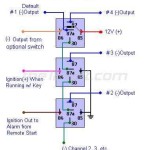Tele 50s Wiring refers to the original electrical wiring configuration used in Fender Telecaster guitars during the 1950s. It features a three-way pickup selector switch with two distinct settings: the bridge pickup alone or the neck and bridge pickups in parallel (combined). The middle position on the switch is not wired and is typically left unused.
The main purpose of Tele 50s Wiring is to provide a simple and effective way to switch between the bright and twangy sound of the bridge pickup and the warmer and fuller sound of the neck pickup. The parallel wiring of the neck and bridge pickups in the middle position creates a unique and versatile tone that blends the characteristics of both pickups.
This wiring configuration has become a classic in the world of electric guitars, and it continues to be used by guitarists of all genres. Its relevance lies in its ability to deliver a wide range of tonal options from a single guitar, making it suitable for various musical styles. One key historical development in Tele 50s Wiring is the addition of a fourth pickup position in the early 1960s, which allowed for the selection of the neck pickup alone.
As we delve deeper into the rich history and technical aspects of Tele 50s Wiring, we will explore its significance in the evolution of the electric guitar, its impact on popular music, and the various modifications and variations that have emerged over the years.
Tele 50s Wiring, a crucial aspect of Fender Telecaster guitars, encompasses a range of essential elements that contribute to its unique sonic characteristics and functionality. Understanding these key aspects is vital for appreciating the significance of this wiring configuration in the realm of electric guitars.
- Pickup Selection: Tele 50s Wiring features a three-way pickup selector switch that allows the player to choose between the bridge pickup, neck pickup, or a combination of both.
- Parallel Wiring: The neck and bridge pickups are wired in parallel in the middle position, resulting in a blend of their individual tones.
- Tone Control: The wiring includes a single tone control that affects the brightness of the pickups, offering a range of tonal options.
- Simplicity: Tele 50s Wiring is known for its straightforward design, making it easy to use and maintain.
- Versatility: This wiring configuration provides a wide array of sounds, from the twangy bridge pickup to the warmer neck pickup and the unique blend in the middle position.
- Historical Significance: Tele 50s Wiring has been used on Fender Telecaster guitars since the 1950s, making it a classic and influential wiring configuration.
- Impact on Music: The distinct tones produced by Tele 50s Wiring have shaped the sound of countless genres, including rock, blues, and country.
- Modifications: Over the years, various modifications and variations of Tele 50s Wiring have emerged, expanding its tonal possibilities.
- Relevance Today: Tele 50s Wiring remains a popular choice among guitarists, offering a timeless and versatile sound.
These key aspects of Tele 50s Wiring highlight its enduring significance in the world of electric guitars. Its ability to deliver a range of tones, its historical impact, and its continued relevance make it a cornerstone of electric guitar design.
Pickup Selection
The pickup selector switch is a critical component of Tele 50s Wiring, enabling the player to access the distinct tonal characteristics of the bridge and neck pickups, as well as a unique blend of both. This versatility is a defining feature of Tele 50s Wiring and contributes to its enduring popularity among guitarists.
The bridge pickup, known for its bright and twangy sound, is ideal for genres like country and rock. The neck pickup, on the other hand, produces a warmer and fuller tone, making it suitable for blues and jazz. The middle position, which combines both pickups, offers a versatile blend that can accommodate a wide range of musical styles.
Real-life examples of Tele 50s Wiring in action can be found in countless recordings and performances. For instance, guitarists such as Keith Richards, Bruce Springsteen, and Muddy Waters have utilized this wiring configuration to achieve their signature sounds. Its versatility allows players to switch between pickup combinations effortlessly, adapting to different musical contexts and styles.
Understanding the connection between pickup selection and Tele 50s Wiring is essential for guitarists seeking to harness the full potential of this classic wiring configuration. By exploring the tonal characteristics of each pickup and the unique blend created by the middle position, guitarists can unlock a wide sonic palette.
In summary, the three-way pickup selector switch in Tele 50s Wiring is a crucial element that provides guitarists with a versatile range of tonal options. Its ability to access the distinct sounds of the bridge and neck pickups, as well as their combination, makes Tele 50s Wiring a timeless and influential wiring configuration in the world of electric guitars.
Parallel Wiring
Parallel Wiring is a critical component of Tele 50s Wiring, enabling the unique tonal blend of the middle position. When the neck and bridge pickups are wired in parallel, their signals are combined before being sent to the output jack. This results in a sound that retains the characteristics of both pickups, creating a fuller and more versatile tone.
Real-life examples of Parallel Wiring in Tele 50s Wiring can be heard in the playing of countless guitarists, including Keith Richards, Bruce Springsteen, and Muddy Waters. These players have harnessed the versatility of the middle position to achieve their signature sounds, blending the twang of the bridge pickup with the warmth of the neck pickup.
Understanding the relationship between Parallel Wiring and Tele 50s Wiring is essential for guitarists seeking to explore the full range of tonal possibilities offered by this classic wiring configuration. By combining the signals from both pickups, Parallel Wiring creates a unique and versatile sound that can adapt to a wide range of musical styles.
In summary, Parallel Wiring is a defining characteristic of Tele 50s Wiring, contributing to its enduring popularity and tonal versatility. Guitarists can leverage this understanding to unlock a wider sonic palette, blending the distinct sounds of the bridge and neck pickups to create a unique and expressive sound.
Tone Control
Tone Control is a crucial aspect of Tele 50s Wiring, allowing guitarists to shape the overall brightness of their sound. This single control, typically located on the guitar’s body, provides a range of tonal options, from bright and twangy to warm and mellow.
- Capacitance: The tone control works by introducing capacitance into the circuit, which acts as a filter to reduce high frequencies. By adjusting the amount of capacitance, guitarists can fine-tune the brightness of their sound.
- Real-Life Examples: Many legendary guitarists have utilized the tone control in Tele 50s Wiring to achieve their signature sounds. Keith Richards, for instance, often rolls off the tone slightly to achieve his trademark warm and bluesy tone.
- Tonal Versatility: The tone control’s ability to adjust brightness makes it a versatile tool for guitarists. By rolling off the tone, guitarists can create a warmer sound suitable for genres like jazz and blues. Conversely, boosting the tone produces a brighter sound ideal for country and rockabilly.
- Interaction with Pickups: The tone control interacts with the pickups to shape the overall sound of the guitar. Different pickup configurations, such as single-coils or humbuckers, will react differently to the tone control, yielding a unique range of tonal possibilities.
In summary, the Tone Control in Tele 50s Wiring is a powerful tool that enables guitarists to tailor the brightness of their sound. Its interaction with the pickups and its ability to produce a wide range of tones make it an essential component of this classic wiring configuration.
Simplicity
Simplicity is a defining characteristic of Tele 50s Wiring, contributing to its enduring popularity among guitarists. Its straightforward design, with a three-way pickup selector, single tone control, and parallel wiring, makes it easy to use and maintain, even for beginners.
The simplicity of Tele 50s Wiring allows guitarists to focus on playing and experimenting with different tones, without getting bogged down by complex electronics. This ease of use is a significant advantage, especially in live performance situations where quick adjustments may be necessary.
Real-life examples of the simplicity of Tele 50s Wiring can be found in countless guitarists who have used it to achieve their signature sounds. Keith Richards, known for his iconic Telecaster tone, has praised the simplicity of the wiring, enabling him to quickly switch between pickups and adjust the tone to suit different musical contexts.
Understanding the connection between simplicity and Tele 50s Wiring is essential for guitarists seeking a versatile and user-friendly wiring configuration. Its straightforward design makes it an excellent choice for beginners, while its tonal capabilities satisfy even the most experienced players.
In summary, the simplicity of Tele 50s Wiring is a key factor contributing to its enduring popularity. Its ease of use, maintenance, and adaptability make it an ideal choice for guitarists seeking a classic and versatile wiring configuration.
Versatility
The versatility of Tele 50s Wiring stems directly from its unique pickup configuration and parallel wiring. The three-way pickup selector switch allows guitarists to choose between the bridge pickup, neck pickup, or a combination of both, providing a wide range of tonal options. The parallel wiring in the middle position blends the signals from both pickups, creating a unique and versatile sound that is distinct from either pickup alone.
Real-life examples of the versatility of Tele 50s Wiring can be heard in the playing of countless guitarists, including Keith Richards, Bruce Springsteen, and Muddy Waters. These players have used Tele 50s Wiring to achieve their signature sounds, demonstrating the versatility of this wiring configuration across genres such as rock, blues, and country.
Understanding the connection between versatility and Tele 50s Wiring is essential for guitarists seeking a wiring configuration that can accommodate a wide range of musical styles and playing techniques. The ability to switch between pickup combinations and adjust the tone allows guitarists to adapt their sound to different musical contexts and personal preferences.
In summary, the versatility of Tele 50s Wiring is a key factor contributing to its enduring popularity among guitarists. Its ability to provide a wide array of sounds, from the twangy bridge pickup to the warmer neck pickup and the unique blend in the middle position, makes it a versatile and adaptable wiring configuration.
Historical Significance
The historical significance of Tele 50s Wiring lies in its enduring use on Fender Telecaster guitars since the 1950s. This wiring configuration has played a pivotal role in shaping the sound of countless iconic guitarists and has become a cornerstone of electric guitar design.
- Origin and Evolution: Tele 50s Wiring emerged as the standard wiring configuration for Fender Telecaster guitars in the 1950s. Its simplicity and versatility quickly made it a favorite among guitarists, and it has remained largely unchanged over the decades.
- Iconic Players: Tele 50s Wiring has been used by some of the most influential guitarists in history, including Keith Richards, Bruce Springsteen, and Muddy Waters. These players have helped to popularize the Telecaster’s sound and establish Tele 50s Wiring as a classic configuration.
- Contribution to Popular Music: The Telecaster’s unique sound, shaped in part by Tele 50s Wiring, has played a major role in the development of popular music genres such as rock, blues, and country. Its versatility has made it a go-to guitar for countless guitarists.
- Enduring Legacy: Tele 50s Wiring continues to be a popular choice for guitarists today, both for its historical significance and its timeless sound. Its simplicity and versatility make it a versatile option for a wide range of musical styles.
The historical significance of Tele 50s Wiring is undeniable. Its enduring use on Fender Telecaster guitars, its association with iconic guitarists, its contribution to popular music, and its timeless sound have cemented its place in the history of electric guitar design.
Impact on Music
The Telecaster’s distinctive sound, shaped in part by Tele 50s Wiring, has profoundly influenced the development of popular music genres such as rock, blues, and country. The bright twang of the bridge pickup and the warm, full sound of the neck pickup, blended together in the middle position, provide guitarists with a versatile range of tonal options that have been embraced by countless iconic players.
One prime example is Keith Richards of The Rolling Stones, whose Telecaster, affectionately known as “Micawber,” has become synonymous with his signature sound. Richards’ use of Tele 50s Wiring allows him to switch seamlessly between the Telecaster’s distinct tonal characteristics, from the piercing twang of the bridge pickup on songs like “Honky Tonk Women” to the warmer, fuller sound of the neck pickup on ballads like “Wild Horses.”
Another notable example is Bruce Springsteen, whose Telecaster has been a constant companion throughout his career. Springsteen’s Telecaster, with its Tele 50s Wiring, delivers the perfect blend of twang and warmth that has become a defining element of his sound. From the jangly intro of “Born to Run” to the soaring solos in “Thunder Road,” Springsteen’s Telecaster, with its Tele 50s Wiring, has played a pivotal role in shaping his iconic sound.
Understanding the connection between Tele 50s Wiring and its impact on music is crucial for guitarists seeking to emulate their favorite players or explore new sonic territories. The distinct tones produced by Tele 50s Wiring have left an indelible mark on popular music, and continue to inspire guitarists of all levels.
Modifications
Tele 50s Wiring has served as a foundation for countless modifications and variations, driven by guitarists’ insatiablefor new and unique sounds. These modifications range from simple component swaps to complex rewiring schemes, each offering its distinct sonic signature.
One of the most common modifications is the replacement of the traditional three-way pickup selector switch with a four-way or five-way switch. This allows guitarists to access additional pickup combinations, such as the neck and bridge pickups in series or the neck pickup with both tone controls engaged.
Another popular modification is the addition of a third pickup, typically a single-coil or humbucker, in the middle position. This configuration, known as the “Texas Tele,” provides even greater tonal versatility, allowing guitarists to blend the twang of the bridge pickup with the warmth of the neck pickup and the added punch of the middle pickup.
Understanding the relationship between Tele 50s Wiring and its various modifications is crucial for guitarists seeking to customize their instruments and explore new sonic territories. By experimenting with different pickup combinations, wiring schemes, and components, guitarists can tailor their Telecaster’s sound to suit their individual playing style and musical preferences.
In summary, the modifications and variations of Tele 50s Wiring have played a significant role in expanding the tonal possibilities of the Telecaster guitar. From simple component swaps to complex rewiring schemes, these modifications have allowed guitarists to create a vast array of unique and versatile sounds, contributing to the Telecaster’s enduring popularity and influence in the world of electric guitars.
Relevance Today
The enduring relevance of Tele 50s Wiring lies in its timeless appeal and versatility, which have made it a popular choice among guitarists across generations and genres. This wiring configuration offers a unique combination of simplicity, tonal variety, and historical significance, contributing to its continued relevance in the world of electric guitars.
Real-life examples of Tele 50s Wiring’s enduring relevance can be found in the countless guitarists who continue to use it to achieve their signature sounds. From Keith Richards and Bruce Springsteen to modern players like John Mayer and Andy Summers, Tele 50s Wiring has proven its adaptability to a wide range of musical styles and playing techniques.
Understanding the connection between Tele 50s Wiring and its enduring relevance is crucial for guitarists seeking to emulate their favorite players or explore new sonic territories. By mastering the nuances of this wiring configuration, guitarists can harness its versatility to create a vast array of tones, from the twangy bridge pickup to the warm neck pickup and the unique blend in the middle position.
The continued relevance of Tele 50s Wiring is a testament to its enduring appeal and sonic versatility. Its simplicity, tonal options, and historical significance have made it a cornerstone of electric guitar design, and it continues to inspire and influence guitarists of all levels.










Related Posts








